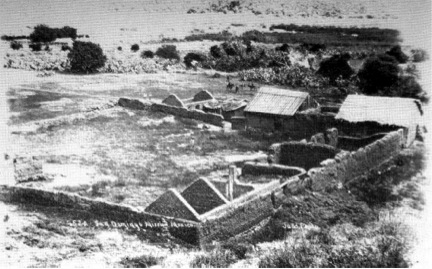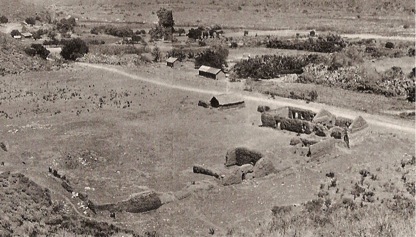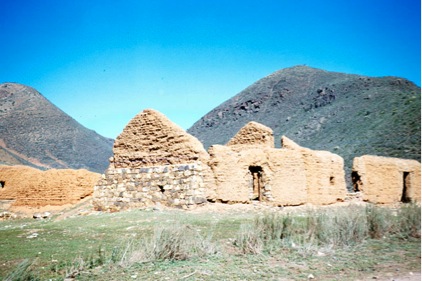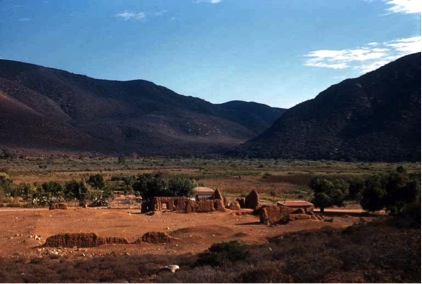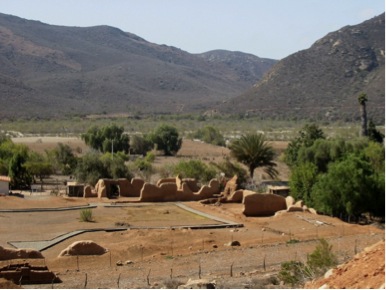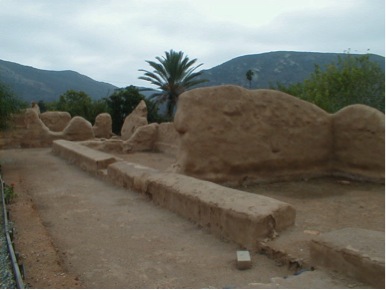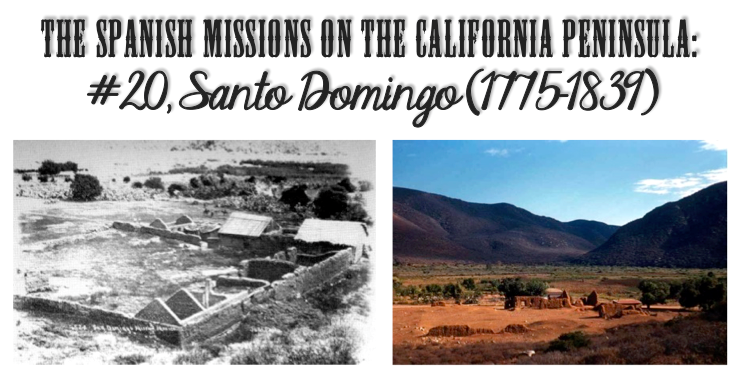
By David Kier
www.vivabaja.com
Co-author of ‘The Old Missions of Baja & Alta California, 1697-1834’
One year following the founding of their first mission (El Rosario), the Dominicans were ready to begin the second mission of their California service. Padre Manuel Garcia and Padre Miguel Hidalgo traveled twenty leagues (about 50 miles) north to a site where a large arroyo emerged from the mountains. This was on or about August 30, 1775 and they named the new mission Santo Domingo. The first services were held in a cave at the base of a large red rock, on the south side of the arroyo. The mission church was soon constructed, near the cave.
Padre Garcia was at Santo Domingo until late 1776 and was then succeeded by Padre José Aivar, who was on duty until the end of 1791. Other Dominicans performed functions at Santo Domingo during his time as resident priest. One was Padre Luis Sales, who performed baptisms here in 1778 and 1779. Luis Sales was the only Dominican in California to have some of his letters published. Sales wrote that the Indians of Santo Domingo (and San Vicente) were “unquiet, subversive and inclined to revolt”. A terrible smallpox epidemic killed a third of the population in 1781.
In 1782, the mission’s neophyte population was only 79. Getting Indians to live at Santo Domingo was more difficult than at other missions, where food offered by the missionaries had bribed them away from their native homes. The problem for Santo Domingo was that most of the Indians lived along the coast and on San Quintin Bay, 20 miles away. The mission’s agricultural program required quantities of fresh water to grow crops and raise livestock. The natives had survived on far less water but there was plenty of fresh sea food. Salt flats near the bay provided for the salt needs of the northern Dominican missions. Sea otters, sold to the Russians, were an important source of revenue, along with sales of salt.
The next resident missionary was Padre Miguel Abad who was stationed here from January, 1792 to September, 1804. In 1793, the church was made of adobe and poles. It measured approximately 22 by 50 feet in size. In 1798, a large chapel with additional rooms and a kitchen was constructed 2.6 miles to the east, where the 23 year old mission would be moved. This placed the mission closer to a better water supply.
By 1799, a cattle ranch outpost was made at San Telmo, about 16 miles north. Construction of addition buildings continued at both Santo Domingo and San Telmo. San Telmo was an important visita of Santo Domingo and has been populated continually since mission times. In 1800, the neophyte population at Santo Domingo increased to 315.
Padre José Miguel de Pineda was next in charge at Santo Domingo and made entries in the mission books until August 24, 1809. Many other Dominicans also officiated during these years. The next resident priests listed in the book of records were Bernardo Solá (1809-1811), Roque Valera (1811-1812), José Duro (1812-1819), and Domingo Luna (1820-1821). Very few baptisms appear in the following years and it is uncertain if a resident priest was even living at Santo Domingo after 1821. Large gaps in recording events began after 1822. The next entries into the mission books were made in 1827 and 1828. The population was down to 78 in 1830. The final entries made into the mission book began again in 1832 and were made each year to 1836, then in 1838, and the final baptism was on March 18, 1839.
An interesting story comes from the pen of the late editor of Desert Magazine, Choral Pepper:
In the late 1920s the buildings were still intact with embroidered altar cloths, carved wooden saints, and bells hanging from a crossbar in front of the mission. The faithful then had a superstition that so long as the bells hung in their rightful place, peace and health would dwell in the pueblo. Then one night in 1930, the bells were stolen. Immediately several older residents dropped dead. After that, the mission fell into ruin and its altarpieces disappeared.
While editor of Desert magazine, I was told a story by a reliable reader that might explain the disappearance of the wooden saints. On a visit to Santo Domingo, she had personally examined four carved wooden mission figures, each about three feet high and so heavy that it required the efforts of several strong men to lift them. She was told that the mission’s last priest had left the saints in the care of a local farmer. Responsibility for their safekeeping had been passed from one surviving senior member of the community to the next eldest upon the death of each in turn. Originally there had been five figures, she was told, but one had been loaned to a neighboring village for a festival and never returned. At that time, they resided in a shed at the rear of a farmhouse near the mission.
An early traveler who discovered gold dust clinging to their hollowed insides reportedly found a different set of figures, similar except in size.
To reach Santo Domingo, take a wide, graded dirt road east for 5 miles (from Km. 169 on Highway 1), just north of the Santo Domingo river crossing.

A 1955 photo by Howard Gulick at the first Santo Domingo mission church ruins. Note the HR for Hamilton Ranch, a fly-in guest ranch of the mid 1900’s, located very near the first mission site.
David Kier is co-author of ‘The Old Missions of Baja & Alta California, 1697-1834’. The book is available for purchase HERE or at the DBTC offices (call 800-727-2252).

